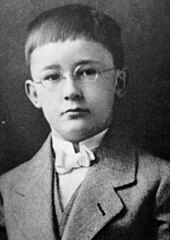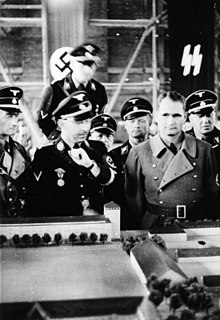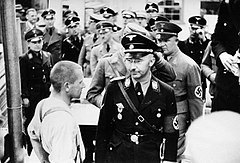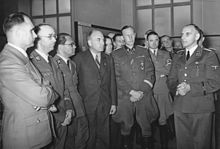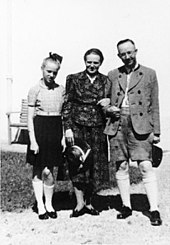Heinrich Himmler
As the principal enforcer of the Nazis' racial policies, Himmler was responsible for operating concentration and extermination camps as well as forming the Einsatzgruppen death squads in German-occupied Europe.
[2] A day before the launch of Operation Barbarossa in June 1941, Himmler commissioned the drafting of Generalplan Ost, which was approved by Hitler in May 1942 and implemented by the Nazi regime, resulting in the deaths of approximately 14 million people in Eastern Europe.
In the last years of the Second World War, Hitler appointed Himmler as Commander of the Replacement Army and General Plenipotentiary for the administration of the Third Reich (Generalbevollmächtigter für die Verwaltung).
[22] After the murder of Foreign Minister Walther Rathenau on 24 June, Himmler's political views veered towards the radical right, and he took part in demonstrations against the Treaty of Versailles.
Disappointed by his failure to make a career in the military and his parents' inability to finance his doctoral studies, he was forced to take a low-paying office job after obtaining his agricultural diploma.
[26][27] As a member of Röhm's paramilitary unit, Himmler was involved in the Beer Hall Putsch—an unsuccessful attempt by Hitler and the Nazi Party to seize power in Munich.
There he met Rudolf Höss, who was later commandant of Auschwitz concentration camp, and Walther Darré, whose book The Peasantry as the Life Source of the Nordic Race caught Hitler's attention, leading to his later appointment as Reich Minister of Food and Agriculture.
[35][39][40] Upon the resignation of SS commander Erhard Heiden in January 1929, Himmler assumed the position of Reichsführer-SS with Hitler's approval;[38][41][a] he still carried out his duties at propaganda headquarters.
[48] Hitler was appointed Chancellor of Germany by President Paul von Hindenburg on 30 January 1933, heading a short-lived coalition of his Nazis and the German National People's Party.
Applicants were vetted for Nordic qualities—in Himmler's words, "like a nursery gardener trying to reproduce a good old strain which has been adulterated and debased; we started from the principles of plant selection and then proceeded quite unashamedly to weed out the men whom we did not think we could use for the build-up of the SS.
[39] Its features included isolation of victims from the outside world, elaborate roll calls and work details, the use of force and executions to exact obedience, and a strict disciplinary code for the guards.
[87] In September 1939, following the outbreak of World War II, Himmler formed the SS-Reichssicherheitshauptamt (RSHA: Reich Security Main Office) to bring the SiPo (which included the Gestapo and Kripo) and the SD together under one umbrella.
[93] Hitler's primary motivations for war included obtaining additional Lebensraum ("living space") for the Germanic peoples, who were considered racially superior according to Nazi ideology.
[96] Longerich wrote that, while the Nazi movement as a whole launched itself against Jews and Communists, "by linking de-Christianisation with re-Germanization, Himmler had provided the SS with a goal and purpose all of its own".
This task does not consist solely in overcoming an ideological opponent but must be accompanied at every step by a positive impetus: in this case that means the reconstruction of the German heritage in the widest and most comprehensive sense.
The Einsatzgruppen (SS task forces) had originally been formed by Heydrich to secure government papers and offices in areas taken over by Germany before World War II.
Germany subsequently invaded Denmark and Norway, the Netherlands, and France, and began bombing Great Britain in preparation for Operation Sea Lion, the planned invasion of the United Kingdom.
[104] Himmler stated openly: "It is a question of existence, thus it will be a racial struggle of pitiless severity, in the course of which 20 to 30 million Slavs and Jews will perish through military actions and crises of food supply.
[106] Constantly struggling with the Wehrmacht for recruits, Himmler solved this problem through the creation of Waffen-SS units composed of Germanic folk groups taken from the Balkans and eastern Europe.
"[115] Hitler thus intended to prevent internal friction like that occurring earlier in Poland in 1939, when several German Army generals (including Johannes Blaskowitz) had attempted to bring Einsatzgruppen leaders to trial for the murders they had committed.
As the Germans were pushed back from Moscow in December 1941, signalling that the expected quick defeat of the Soviet Union had failed to materialize, Hitler and other Nazi officials realised that mass deportations to the east would no longer be possible.
A "military virgin", this was the first time he had heard a shot fired in anger or seen dead people and, while looking into the open grave, his coat and perhaps his face were splashed by the brains of a victim.
He was given a demonstration of a mass killing using the gas chamber in Bunker 2 and toured the building site of the new IG Farben plant being constructed at the nearby town of Monowitz.
As laid out in Generalplan Ost, the aim was to enslave, expel or exterminate the native population and to make Lebensraum ("living space") for Volksdeutsche (ethnic Germans).
Half a million residents of the annexed Polish territories, as well as from Slovenia, Alsace, Lorraine, and Luxembourg were deported to the General Government or sent to Germany as slave labour.
[184] General Heinz Guderian talked to Himmler on 9 February and demanded that Operation Solstice, an attack from Pomerania against the northern flank of Marshal Georgy Zhukov's 1st Belorussian Front, should be in progress by the 16th.
On 27 April, Himmler's SS representative at Hitler's HQ in Berlin, Hermann Fegelein, was caught in civilian clothes preparing to desert; he was arrested and brought back to the Führerbunker.
Working as a nurse for the German Red Cross during the war, Margarete was appointed supervisor in one of Germany's military districts, Wehrkreis III (Berlin-Brandenburg).
Himmler adopted the doctrine of Auftragstaktik ("mission command"), whereby orders were given as broad directives, with authority delegated downward to the appropriate level to carry them out in a timely and efficient manner.
Weale states that the SS ideology gave the men a doctrinal framework, and the mission command tactics allowed the junior officers leeway to act on their own initiative to obtain the desired results.
